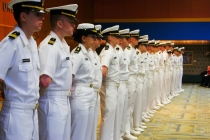The Beginning of the Holloway Bill
In the first week of June 1942, the United States Navy and Marine Corps won a crucial battle against the Japanese at a place called Midway Island, located just west of the Hawaiian Islands. The war at this point had been raging on two fronts for a year and a half, and an offensive for the Americans was finally in sight. However, this newfound campaign to bring the fight to the enemy would now require more men and more importantly, more expert leadership than the military had, so Secretary of the Navy Holloway made a decision that would affect military training for years to come.
In his proposed legislation called the "Holloway Bill" there would be 12 universities and colleges picked to become training centers for enlisted men to become officers, and at the same time receive a higher level of education. Villanova College was one of these schools, and became in July of 1943 an official part of the "V-12" program. Enlisted veterans started pouring from the battlefields, and within several months the school had grown exponentially. There were two basic groups within this new battalion: a company for sailors, and a company for Marines, and all training began in such a manner on the drier parts of the old Mendel field. Although they still kept their enlisted rank, the men were now for all purposes students, with a very intense and speedy schedule of classes. The average program lasted about 4 months, with the student graduating and being sent back to the war as a new officer.
At the war's end, the V-12 program continued to be of use for the Navy, but in much smaller numbers as they were not needed as quickly. The GI Bill was now bringing large amounts of veterans to the schools as civilians, and more of an emphasis was given to accommodate them and their education. Still, the importance of a officer-training program within a civil institution was noted by the Navy, and so in the spring of 1946 a new program was created to fit the needs of the schools. It was called the Naval Reserve Officers Training Corps, and it was meant to supplement the Naval Academy in producing Naval and Marine Corps officers, as well as to phase out the V-12 program.

